In 1836, the northeastern region of Mexico known as Tejas revolted, fought for its independence, and became The Republic of Texas. In truth, its citizens were mostly farmers from the southern United States who had emigrated to Texas seeking new land, including many people from Mississippi.
Texas remained a proud and separate country for nine years, recognized internationally by Great Britain, France, and the United States, and showed little interest at first in changing. In the United States there was talk of possible annexation of Texas, but adding an area big enough to become three or four new slave-holding states was an explosive political issue the nation was not yet ready to handle.
But by 1843, Texas saw the benefits and safety in becoming a part of the United States and indicated its willingness to join the Union. The Democratic Party made Texas annexation one of the principal issues of the 1844 U. S. presidential campaign, and Mississippi Democrats enthusiastically supported the party candidate, James K. Polk of Tennessee, and the admission of Texas. Polk carried the state by a vote of 25,126 to 19,206. He became U. S. president in March 1845, and in December 1845 Texas became the twenty-eighth U. S. state.
Since Mexico’s independence from Spain in 1821, relations with the United States had always been good. Mexico had modeled her form of government after that of the United States. During the Texas revolt, the United States had been strictly neutral, even allowing weapons for the Mexican Army to be shipped through New Orleans.
Mexico breaks diplomatic relations
Nevertheless, when in March 1845 the United States Congress began formalities to take in Texas – Mexico’s lost territory – Mexico’s pride was deeply hurt and she became angry. Bitterly denouncing her old friend, Mexico broke their diplomatic relations, called her resident minister home from Washington, D.C., and threatened renewed war against both Texas and the United States.
Inaugurated as the new U. S. president only days before, Polk was most anxious to soothe Mexican feelings and to keep peace. Even before his election, Polk had high hopes of persuading Mexico to sell the United States her northwestern territories of California and New Mexico, just as the United States had purchased Louisiana from France in 1803. In all that vast expanse there were only about 40,000 people, and it had never really been governed by either Spain or Mexico.
Polk also feared that Great Britain or Russia might be secretly scheming to seize California. He was prepared to pay Mexico $40 million for this land, a huge sum at the time. He knew American land-seekers in covered wagons were already heading to Utah, Oregon, and California. And Polk could sense the growing national opinion that America must one day stretch “from sea to shining sea.”
By late 1845, Mexico had cooled down enough for Polk to learn through contacts in Mexico City that a “commissioner” from him personally would be received there to try to resolve their differences peacefully. Polk sent Commissioner John Slidell. But once Slidell was in Mexico, all officials refused to see him, he was treated discourteously, and he returned empty-handed to Washington, D.C.
Before Slidell departed for Mexico, as a precaution, President Polk sent General Zachary Taylor with a small U. S. Army force of 3,000 men to Corpus Christi, Texas. With Slidell’s failure and new threats from Mexico, Polk raised the force to 4,000 and ordered Taylor to the Rio Grande River, claimed by Texas as a boundary but disputed by Mexico, which claimed the Nueces River as boundary. In doing this, Polk’s hope still was to pressure Mexico to back down and negotiate.
However, a Mexican Army of 5,000 soon arrived on the Rio Grande’s opposite bank, and its general – politely and in writing – notified Taylor that for Mexico war had begun. In early April 1846, Mexican cavalry began to cross the river and ambush American scouting patrols. One ambush killed eleven Americans, wounded six, and took eighty-one prisoners over to Matamoros. With that, Taylor notified Polk and urgently asked for regiments of volunteers to help him since the entire regular U. S. Army at the time numbered only 7,000.
U.S. declares war
It took thirteen days for General Taylor’s dispatch to reach Washington, arriving by coincidence the same day Commissioner Slidell reached the city to give Polk more details of his treatment in Mexico City. An angry U. S. Congress, at Polk’s request, declared war on Mexico on May 13, 1846, and authorized recruitment of 50,000 volunteers.
President Polk looked on the declaration of war as a move to increase pressure on Mexico to negotiate. Polk’s war strategy at first had three objectives: to defend the Rio Grande River boundary; to occupy California and New Mexico; and to inflict just enough punishment on the Mexican Army to force a political settlement favorable to the United States. He hoped and expected that limited action on the Texas frontier would end Mexico’s determination to fight. He decided to begin by calling on the states for a total of only 20,000 volunteers. Congress also authorized President Polk to appoint colonels and six brigadier generals from civilian life to command the volunteer regiments.
Recognized as the best of the brigadiers was a pro-slavery leader, John A. Quitman of Natchez, Mississippi, already prominent in the civic and political life of his community and of Mississippi. Boys from Mississippi would soon be under his command in Mexico.
Mississippians volunteer
A wave of patriotic fervor brought strong popular support for the war, especially in the western states, both north and south. And it was from the western states that the first 20,000 were called. Easterners could be requested later, if needed. The governor of Illinois was asked for four regiments of 1,000 men each to serve for one year, Ohio and Indiana were asked for three regiments, Kentucky and Tennessee for two, and Georgia, Alabama, and Mississippi for only one regiment.
But in Mississippi the response to a call for 1,000 volunteers was so overwhelming that by June 1, an estimated 17,000 boys were in Vicksburg wanting to enlist. Mississippi Governor Albert Gallatin Brown hastily requested the Secretary of War to allow the state a larger contingent. When that was denied, he asked that Mississippians be called to fill quotas not filled in other states, but with no success. So a competition was held in Vicksburg among groups from counties all over the state, resulting in a regiment of ten companies of one hundred men, each composed as follows:
Company A - Yazoo Guards
Company B - Wilkinson Guards
Company C - Vicksburg Southrons
Company D - Carroll County Guards
Company E - Jackson Fencibles
Company F - Lafayette Guards
Company G - Raymond Fencibles
Company H - Vicksburg Volunteers
Company I - Holly Springs Guards
Company K - Tombigbee Guards
Before leaving by steamboat for New Orleans to await ships for Texas, the First Mississippi Regiment elected Jefferson Davis of Warren County as its colonel. Davis was serving as a congressman from Mississippi, and would later, during the American Civil War, be president of the Confederate States. Davis was a West Point graduate who had already served in the U. S. Army. When he took command in New Orleans, his thorough training and constant drilling shaped the Mississippians into an outstanding unit that became the recognized favorite of General Taylor. Colonel Davis had another link with General Taylor: he was his son-in-law. Some years before, Colonel Davis had married General Taylor’s daughter, who died only a few months after the wedding. Of particular note was Colonel Davis’s insistence that his men be given the very newest type of rifle. They became so good with them that the regiment throughout the war was known as the Mississippi Rifles.
March to Monterrey
Back in Texas, before help could arrive, the outnumbered General Taylor had nevertheless won two battles on the Texas side of the Rio Grande at Palo Alto and Resaca de la Palma. The Mexican Army was routed mainly by the American’s light artillery. Taylor then crossed into Mexico to camp near Matamoros. From there he planned to push deeper inland to take the important city of Monterrey, which he did not expect the Mexicans to defend.
Since the country between Matamoros and Monterrey was semi-desert, with little water or grass for pack animals, Taylor decided to make his base for future operations the upriver town of Camargo. Seven steamboats shuttled supplies and men up from the port at the Rio Grande mouth.
Volunteers poured into Camargo and by late July 1846, about 15,000 men were in camp there. But with disregard for sanitation, little immunity from contagious diseases, and the tropical heat, sickness – above all dysentery – began to take a terrific toll. Perhaps 1,500 died before the march toward Monterrey could begin, and others had to be sent home. Indeed, throughout the Mexican-American War sickness was always the greater enemy. Americans killed in action, or dead from battle wounds, would total 1,721, while deaths from diseases would reach more than 10,000.
The Mexicans surprised Taylor and put up a strong defense at Monterrey, but it was taken on September 25, 1846. Brigadier General Quitman, Colonel Davis, and the Mississippi Rifles were all in the thick of the fight. Several soldiers were killed. In fact, of the 119 volunteer units of the Mexican-American War, the Mississippi Rifles lost 59 men in combat, the largest number in any unit. Another 123 Mississippians died in accidents or from disease.
After Monterrey, General Taylor next took Saltillo without a fight. But he then counseled President Polk to open a second front, to seize the port of Veracruz and to march an army the much shorter route to Mexico City. It would be impossible for him to go hundreds of miles farther, with his supply lines from Texas stretched and exposed to attack over such a great distance.
Polk had already considered Taylor’s idea, and in November decided to act on it. But instead of giving General Taylor the command, he appointed Major General Winfield Scott to lead the new army. Taylor was hurt and never forgave Polk for this. But he was even more angry when the War Department then ordered him to send most of his best regular Army units and a large part of his volunteers to General Scott. Brigadier General Quitman departed with them, but not the Mississippi Rifles whom Taylor insisted on keeping with him.
Battle of Buena Vista
Hardly had a part of his army left when Taylor learned that a new Mexican Army of some 15,000 men, including 4,000 excellent cavalry and lancers, was marching north to take back Saltillo and Monterrey under command of the same General Antonio Lopez de Santa Anna who had fought the Texans at the Alamo when Texas first rebelled. General Santa Anna had vowed to push the Americans back across the Rio Grande.
With only 4,650 men left, General Taylor moved them to a narrow pass in the mountains south of Saltillo where the Mexicans could be more easily blocked. There the Battle of Buena Vista raged for two days, February 22 and 23, 1847, with Taylor always keeping the Mississippians in readiness beside him. On the second day when a dangerous break in one key line occurred, he ordered them in to save it. The legend is that he did so, saying, “Steady, boys, steady for the glory of Ole Mississippi!” Colonel Davis placed his ranks into a “V” formation that was much praised after the battle. The Mississippi Rifles not only held fast but turned the enemy back. Night soon fell and the Mexican Army retreated. General Zachary Taylor would become a national hero and in 1850, was elected president of the United States.
During the same months General Taylor was campaigning, another small force led by Colonel Stephen Watts Kearny, composed of regular Army dragoons, Missouri volunteers, and a battalion of Mormons sent by Brigham Young, made the difficult 895-mile march from Kansas to Santa Fe, taking New Mexico without firing a shot. Continuing the grueling march to Los Angeles, where he learned the U. S. Navy was already holding Monterey and San Francisco, Kearny took formal control of all California for the United States.
March to Mexico City
Less than two weeks after Buena Vista, General Scott led the first amphibious landing in U. S. history onto a beach south of Veracruz. Bombarding that port city into submission, this second army began its march to take Mexico City. General Santa Anna now seized the presidency and again attempted to stop the Americans. New volunteer units arrived bringing General Scott’s strength up to 10,738. General Santa Anna retreated to the valley surrounding Mexico City, awaiting the Americans with another army of 30,000.
Santa Anna and his men put up strong resistance at several towns outside the capital, but the Americans pushed them back into the city. On the final assault against its several gates, Brigadier General Quitman at its west gate, on foot and at the head of his men, won heroic distinction. After Mexico City was captured September 14, 1847, General Scott publicly honored John A. Quitman by naming him the military governor of Mexico City.
A new Mexican government some months later signed the Treaty of Guadalupe Hidalgo with the United States. Its principal terms: (1) the United States paid Mexico $15 million and agreed to settle the many debts owed American citizens by former Mexican governments; (2) Mexico gave up her claims to Texas, New Mexico, and California; and (3) all future disputes between the two neighbors would be arbitrated peacefully.
Sam Olden of Yazoo City is a former president of the Mississippi Historical Society who as a diplomat and businessman has lived in Africa, Asia, Europe, and South America.
Lesson Plan
-
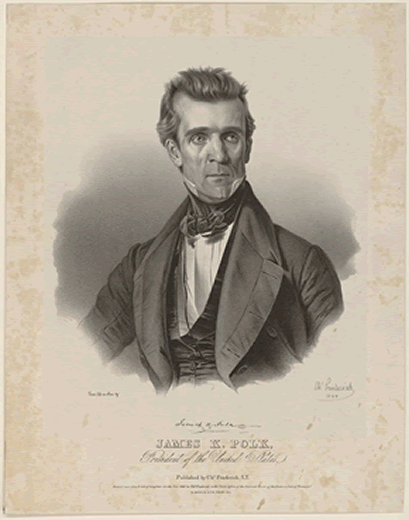
U.S. President James K. Polk. 1845 lithograph courtesy Library of Congress Prints and Photographs Division. LC-DIG-ppmsca-7596 -
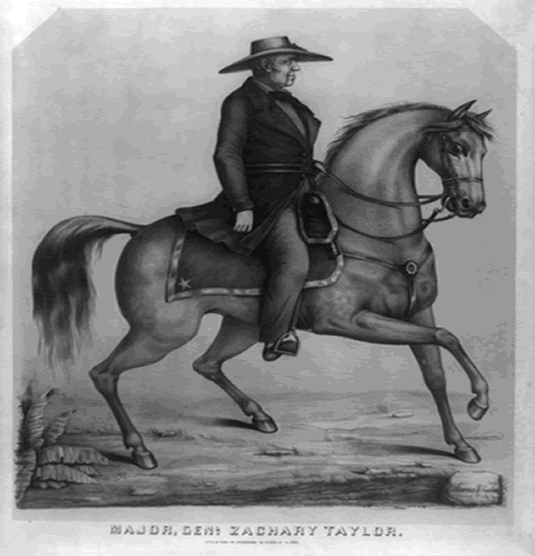
Major General Zachary Taylor. Portrait courtesy Library of Congress Prints and Photographs Division. LC-USZ62-10174
-
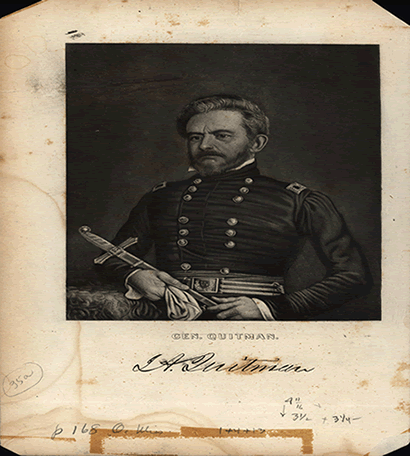
Brigadier General John A. Quitman of Natchez was one of six brigadier generals appointed by President Polk to command volunteer regiments. Photo courtesy Mississippi Department of Archives and History. PI/STA/ Q57/No. 1 -
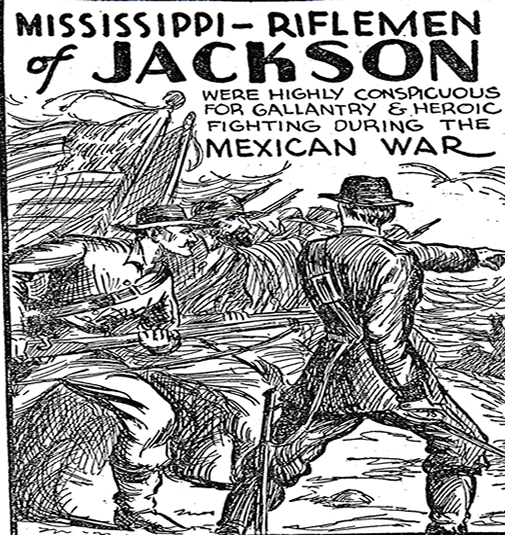
The First Mississippi Regiment, composed of 10 companies, was known throughout the war as the Mississippi Rifles. Drawing courtesy Mississippi Department of Archives and History. Mexican War subject file -
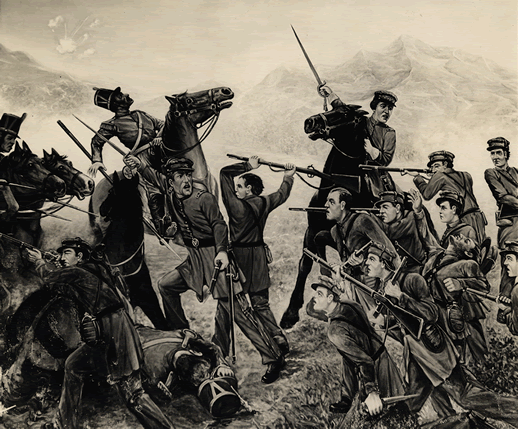
Colonel Jefferson Davis leading the First Mississippi at the Battle of Buena Vista, from a painting by Alexandra Alaux. Detail courtesy of Mississippi Department of Archives and History. PI/PER/D38/No. 50 -
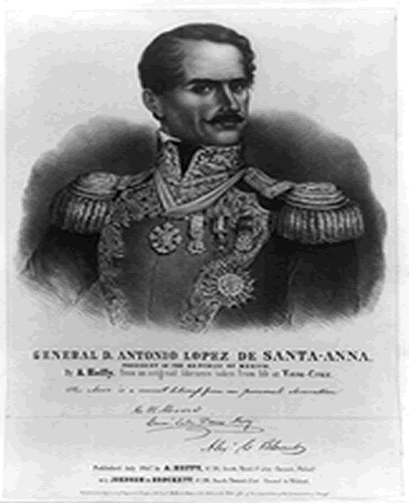
General Antonio Lopez de Santa Anna, circa 1847. Portrait courtesy Library of Congress Prints and Photographs Division. LC USZ62-21276 -
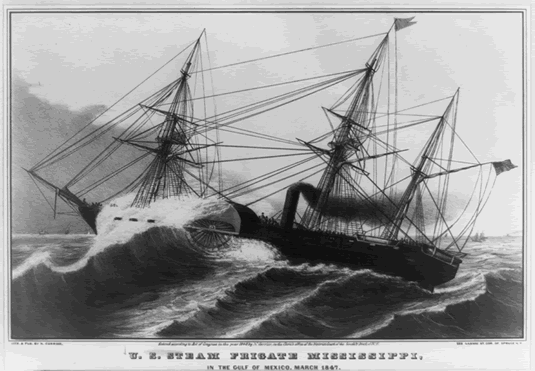
U.S. steam frigate Mississippi in the Gulf of Mexico, March 1847. The United States Navy supported U.S. troops during the war. Currier & Ives print courtesy Library of Congress Prints and Photographs Division. LC-USZ62-93027 -
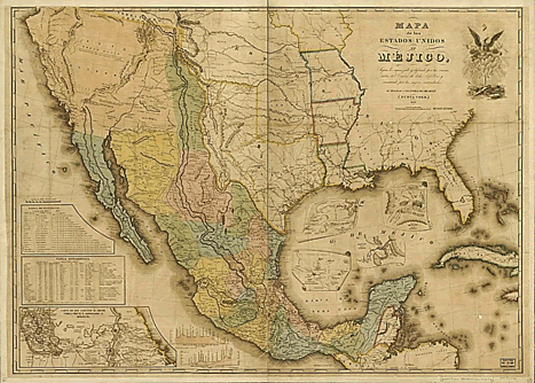
Map of area used for the negotiation of Treaty of Guadalupe Hidalgo. Courtesy Library of Congress Geography and Map Division.
Sources:
Bauer, K. Jack. The Mexican War, 1846-1848. New York: Macmillan Publishing Co., Inc., 1974.
Gonzales, John Edmond. “Flush Times, Depression, War, and Compromise,” in A History of Mississippi, Volume One edited by Richard Aubrey McLemore. Jackson: University and College Press of Mississippi, 1973.
